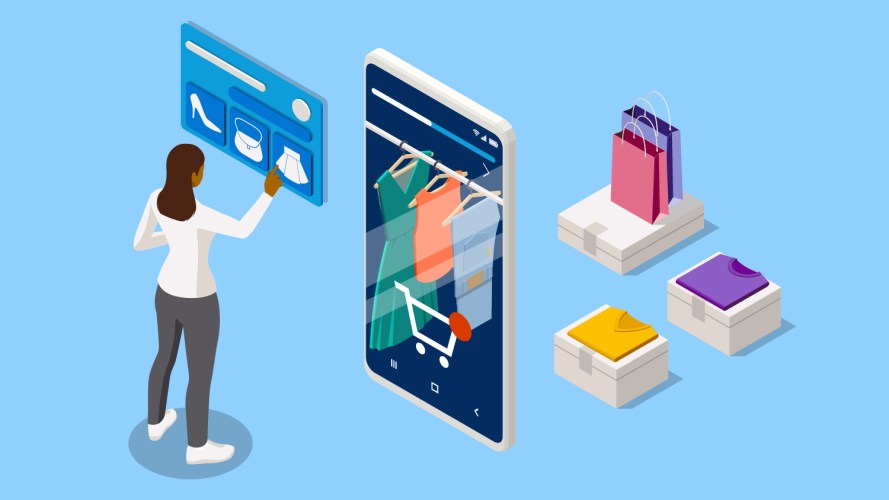3 Ways Generative AI Will Help Marketers Connect With Customers
3 min read


There’s probably a digital merchandiser to thank for a lot of your most treasured purchases, whether it’s apparel in your closet, your favorite toiletries, or home decor. Merchandisers are like the matchmakers of the shopping experience: They connect customers with products they’ll love.
These experts — who curate and categorize items, and make sure they’re findable on a website — are the real MVPs of ecommerce, increasing conversions and revenue. Here’s how ecommerce merchandising works, and how you can use it to increase sales.
Here’s how to increase conversions.



What’s ecommerce merchandising?
Why ecommerce merchandising is more important than ever
How ecommerce merchandising strategies are evolving
Ecommerce merchandising is all about connecting customers with the right products — it’s both an art and a science. It involves creating visually appealing digital displays that entice customers to buy, and ensuring that shoppers can quickly find the products they’re looking for.
Ecommerce merchandising includes the following elements:
When properly implemented, these elements can help you increase conversions, sales, average order value, and other vital metrics.
Your customers — whether they’re consumers or business buyers — are busy people. They want to find what they’re looking for as quickly as possible and complete their transaction.
If your website merchandising tactics don’t reflect this, frustrated customers might end up on your competitors’ site. In fact, 80% of customers say the experience a company provides is as important as its products and services.
As customer expectations continue to rise, it’s critical to focus your website merchandising efforts on efficiency and convenience.
With predictive and generative AI going mainstream, merchandisers now have powerful tools to help them enhance the customer experience. Use these five strategies to stay ahead of the curve.
No two customers are exactly alike. And with the help of data, you can create shopping experiences tailored to each customer’s preferences. In fact, 65% of customers expect companies to adapt to their changing needs and preferences. As technology advances, customers only expect more: 81% of them expect faster service and 73% expect better personalization. Here’s how merchandisers can help bridge the gap.
By taking a data-driven approach, online merchandisers can offer customers the personalized experiences they’re looking for. Using shoppers’ purchase history, location, and the personal information they’ve shared, you can customize their product feeds and send them tailored offers. For example, if you sell apparel and an existing customer is interested only in menswear, you can curate their experience so they see only men’s clothing and shoes in their feed. Targeted, relevant pages lead to happy, satisfied customers.
Learn the 10 most important metrics to track your progress.



First impressions matter. Your home page introduces shoppers to your brand and your entire virtual storefront, so make it engaging and easy to navigate. Place your most important or popular offers at the top of the page, where they’ll be most visible. Offer free shipping? Make sure shoppers know that up front: More than half (52%) of them are willing to spend $25 to $50 in a single transaction in order to get free shipping.
And don’t forget navigation and search. Customers often have specific requirements or preferences when searching for products. By letting them filter and sort products based on attributes such as price, size, color, or brand, they can narrow down their options and quickly find what they’re looking for.
Who likes to add a product to their cart, only to be told it’s out of stock? When it comes to online shopping, few things are more frustrating. Real-time inventory management lets shoppers make informed decisions and helps you better manage your stock levels. By keeping your product inventory visible, customers can see what’s available in real time, and avoid surprises at checkout.

3 min read

6 min read
As technology evolves, so do customer expectations. Customers want convenient, memorable shopping experiences, from browsing to delivery and fulfillment. Here are key ecommerce trends that are changing the landscape of shopping online:
Artificial intelligence. If you have a large product catalog that constantly changes, AI tools can cut the time required to write and categorize individual product descriptions. AI in ecommerce can also help generate SEO meta titles and meta descriptions for entire product categories, saving you hours of work and keeping things organized.
Augmented reality. Offer customers an extra level of personalization by creating AR experiences that let them “try out” products before they buy. Whether it’s seeing how a sofa would look in their living room or previewing the colors on a pair of customized sneakers, 61% of consumers favor AR shopping experiences. Everyone wins: Customers get a more accurate idea of your products, and you get fewer returns.
Product and demo videos. High-quality video content that’s viewable on mobile devices and optimized for SEO can help shoppers find your products. They’re also effective marketing tools, highlighting product features in ways that static images can’t convey. In fact, 89% of consumers said watching a video convinced them to buy a product or service.
Keep your video files as small as possible without reducing their quality. Large video files can slow your site’s load time. The highest conversion rates occur on web pages that load between 0 and 2 seconds.
Social proof and user reviews. Word of mouth is still one of the most powerful marketing tools at your disposal. And with social media, words travel fast. Incorporating social proof like user reviews and testimonials on your product pages helps you build credibility and trust — and it feels authentic. It also shows your shoppers that others use and love your products. Consider the approach taken by cosmetics brands E.l.f. Beauty: It dedicated an entire section of its website to showcase products trending on TikTok.
As consumer expectations evolve with technology, make sure your business is ready for the future of ecommerce. This includes investing in an ecommerce platform that will help you keep up with customer demands, changing trends, and advancing technology. Staying on top of changes and implementing the best ecommerce merchandising practices will make things easier for both you and your customers.
Power growth and increase sales with Commerce Cloud.




Get the latest articles in your inbox.


